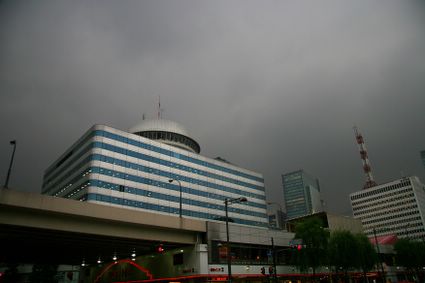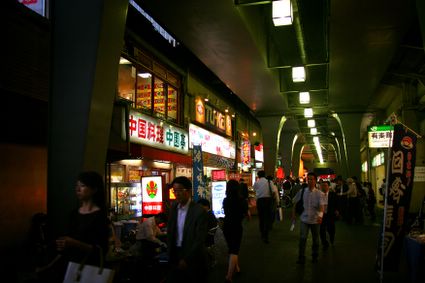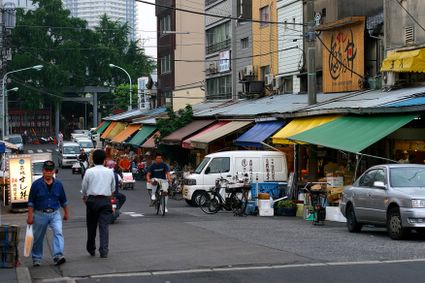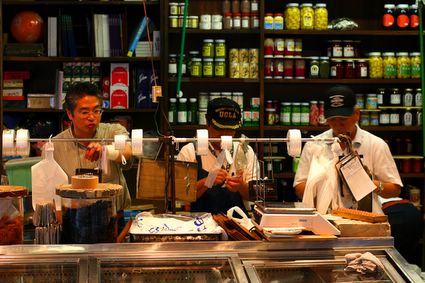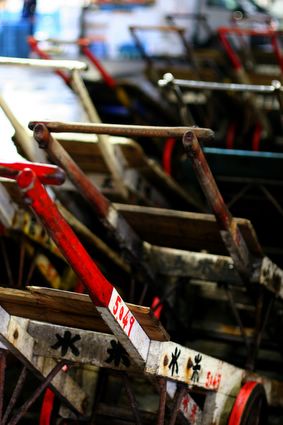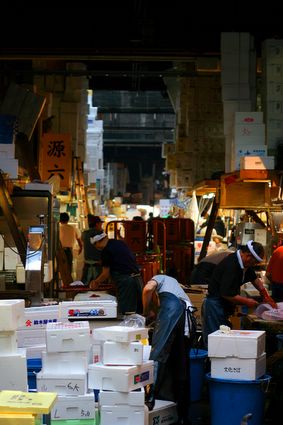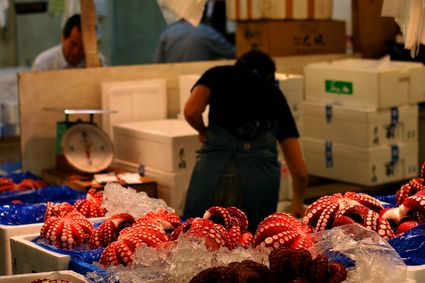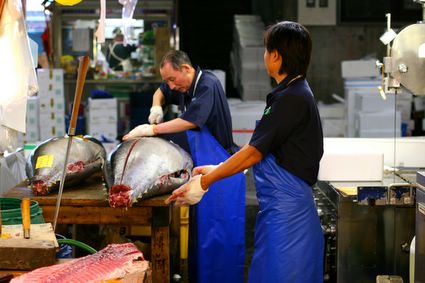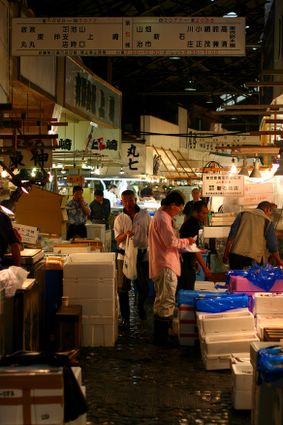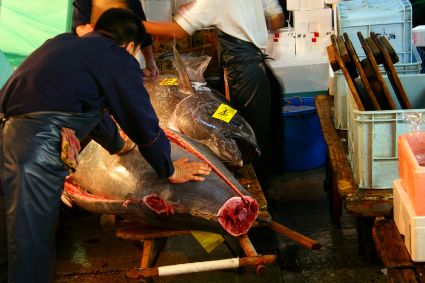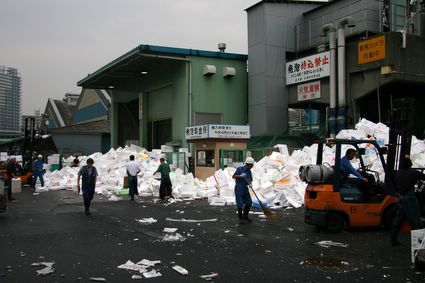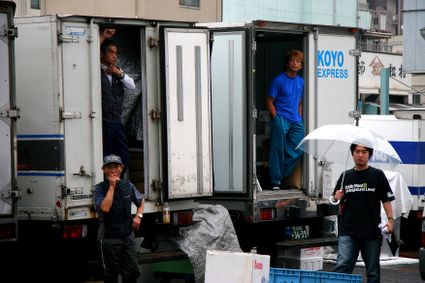Tokyo: Wandering Back to Harajuku
Saturday, July 08, 2006
A couple days after going to the fish market, my friend Gabe flew in from New York, and I had about 9 days to show him Tokyo, the island, and Kyoto. Needless to say we had quite a schedule. In one heroic day, we started at 7:30 and hit the fish market, Shinjuku, Harajuku, Ginza for yakitori lunch, Ikebukuro, back to Harajuku, a nice walk to Shibuya as the sun went down, and then back to the hotel. Considering he was just off the plane the night before with 13 hours of jet lag, Gabe was a trooper. I didn't take very many pictures, but for the day and a half we spent in Tokyo, I have a few. Here they are.
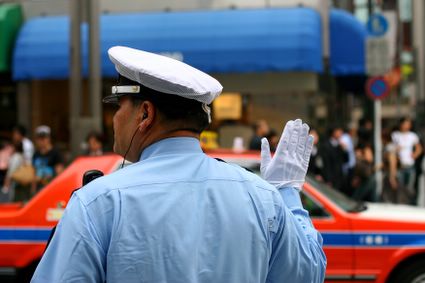
The extremely polite white-gloved police officers of Ginza.
Most of these pictures I'm not exactly sure where I was or what I was doing, they could fall into a category called "Things that caught Ben's interest briefly while he walked around Tokyo."
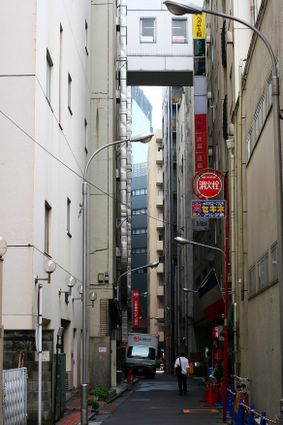
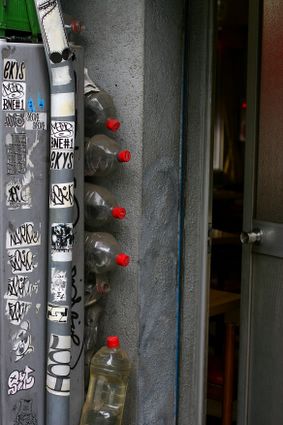
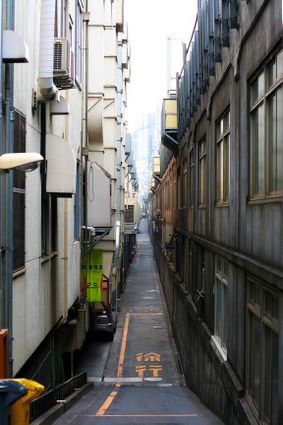

One thing - high school students. In Japan, but especially in the cities, high school students are incredibly cool. Maybe I don't remember high school very clearly, but it seems to me that when I was there, no one was anywhere near as cool as the kids I saw on the street in Tokyo. They have to wear school uniforms, which usually means jackets and ties for the boys with matching pants, and short skirts, high socks, a blouse and a some sort of tie for the girls. Maybe it's because they don't have to pay attention to their clothes, but so many of them have awesome hair, excellent accessories, and the perfect completely aloof look on their faces. I told myself that I wouldn't leave Tokyo without getting one picture of a good group of kids looking as cool as can be. That is actually a tall order, because there's always the risk of looking sketchy, a lone gaijin snapping shots of high school girls in short skirts, but I buckled down and did my best. With every perfecto opportunity that I missed, I wouldn't call this a complete success, but at least when I look at this picture, I'll remember the others, and this girl has got a pretty good look.

Interestingly enough, those skirts are completely normal in Japan. There is simply no taboo on short skirts, as the girls wear them starting in elementary school. It is far more scandalous to show some midriff or wear a low-cut shirt than it is to wear a six inch long skirt. Not to mention that this girl is wearing some frilly red bow on her chest and stands there looking like she owns the city. I don't know anyone back home who could pull that off, especially not when they were in high school.
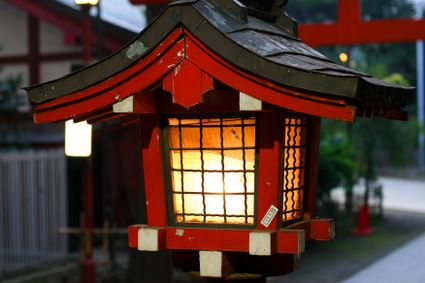
Random lantern: a little temple in Shinjuku.
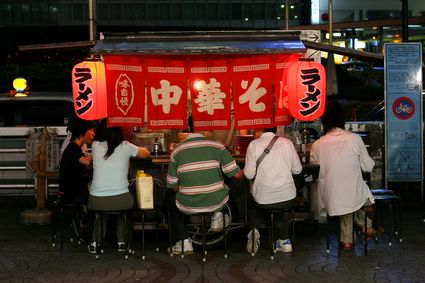
Back to Harajuku
As Harajuku is my favorite place in Tokyo, I made Gabe go twice we went in the morning, took in the people, the shopping, walked the neighborhood a bit, and then went to see if the crazy Harajuku cos-players were there, and they were not. I'll get back to that, but we walked into the park and went to see Meiji-jingu, one of the two big temples in Tokyo.
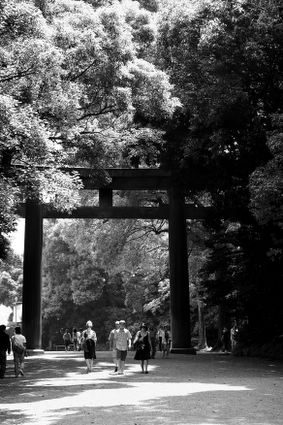
Meiji-jingu seems to be the place to go if you want to have a traditional Japanese wedding, and so look what we found!
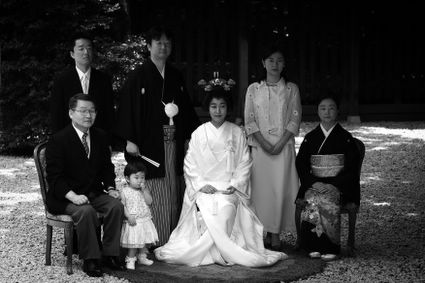
The advantage of sneaking right up behind the photographer and taking a picture - It looks like they were all posing for you. How about this setup though? It looks straight out of the late 19th century.

In Mori's words, "this kind of wedding is so boring. You have to sit seza (on the floor on your knees) for two hours, and then drink some sake. Then you sit for two more hours, and then you drink more sake. Then you sit more."
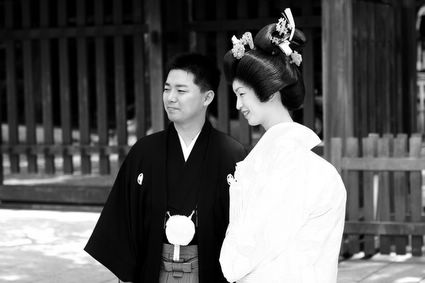
That hair impresses me.
After watching the people, and hanging out a bit more, Gabe and I headed back out through the park. Somehow we got into a situation where we would both take the same picture, and then we would both argue that ours was clearly better. So.

Mine is better.
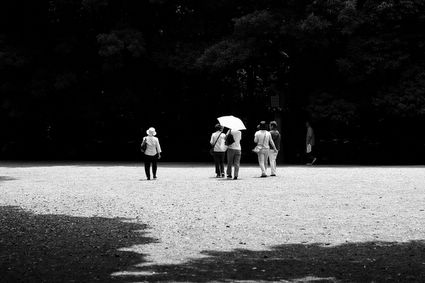
Mine is better.

This one, really - mine is better.
Much later in the day, when we came back, the cos-players were out, and so I decided to take the classic touristy picture. These kids come out on the weekends and wear crazy costumes, usually anime characters, super goths, victorian maids, punks, or some crazy mix of those themes. Lots of men in corsets, high boots, crazy hats and crazier makeup. They arrive looking like normal kids with a small rolling suitcase, they change, and then they sit around for the day, being seen and photographed, enjoying the attention. When Gabe and I got there, we surveyed the scene. There were three girls in ridiculous outfits posing for a photographer, some kids packing up, and then off to one side there was a guy sitting away from his friends, looking scary. Gabe and I at first agreed that he was probably too scary to go over to, but then I decided that if I didn't take the picture I would regret it forever, and besides, I had to show how tough I was now after a year in Japan.
As I wandered over to the guy, his eyes lit up. I asked him in Japanese if I could take a picture and he was on his feet with a big smile on his face and getting into a pose before I finished the question. I wanted him sitting, so I used my essential classroom Japanese ("sit down please") and elicited hoots of approval from his friends. He sat down and got into his pose, which was the most serious thing I have ever seen. This pose was heavily practiced, and involved a number of hand gestures as well that I didn't get in the photo. I took a couple pictures, and then passed the camera to him so he could look at the pictures.

The big smile came back right away, and he passed back the camera and said "good! I like...picture!" I told him his English was amazing, and he said (in Japanese) "ok, now take my friends' pictures." And so I did.
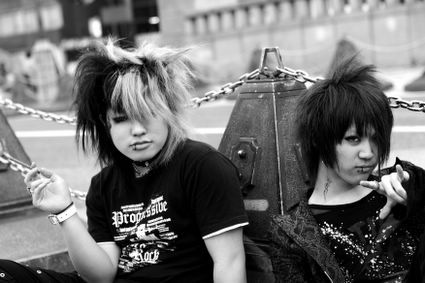
It was too funny. These super serious kids acted just like my students when I actually talked the them, and they all waved and said their best "see you! good bye!" when I left.
I love Japan. How could you not after something like that?

The extremely polite white-gloved police officers of Ginza.
Most of these pictures I'm not exactly sure where I was or what I was doing, they could fall into a category called "Things that caught Ben's interest briefly while he walked around Tokyo."




One thing - high school students. In Japan, but especially in the cities, high school students are incredibly cool. Maybe I don't remember high school very clearly, but it seems to me that when I was there, no one was anywhere near as cool as the kids I saw on the street in Tokyo. They have to wear school uniforms, which usually means jackets and ties for the boys with matching pants, and short skirts, high socks, a blouse and a some sort of tie for the girls. Maybe it's because they don't have to pay attention to their clothes, but so many of them have awesome hair, excellent accessories, and the perfect completely aloof look on their faces. I told myself that I wouldn't leave Tokyo without getting one picture of a good group of kids looking as cool as can be. That is actually a tall order, because there's always the risk of looking sketchy, a lone gaijin snapping shots of high school girls in short skirts, but I buckled down and did my best. With every perfecto opportunity that I missed, I wouldn't call this a complete success, but at least when I look at this picture, I'll remember the others, and this girl has got a pretty good look.

Interestingly enough, those skirts are completely normal in Japan. There is simply no taboo on short skirts, as the girls wear them starting in elementary school. It is far more scandalous to show some midriff or wear a low-cut shirt than it is to wear a six inch long skirt. Not to mention that this girl is wearing some frilly red bow on her chest and stands there looking like she owns the city. I don't know anyone back home who could pull that off, especially not when they were in high school.

Random lantern: a little temple in Shinjuku.

Back to Harajuku
As Harajuku is my favorite place in Tokyo, I made Gabe go twice we went in the morning, took in the people, the shopping, walked the neighborhood a bit, and then went to see if the crazy Harajuku cos-players were there, and they were not. I'll get back to that, but we walked into the park and went to see Meiji-jingu, one of the two big temples in Tokyo.

Meiji-jingu seems to be the place to go if you want to have a traditional Japanese wedding, and so look what we found!

The advantage of sneaking right up behind the photographer and taking a picture - It looks like they were all posing for you. How about this setup though? It looks straight out of the late 19th century.

In Mori's words, "this kind of wedding is so boring. You have to sit seza (on the floor on your knees) for two hours, and then drink some sake. Then you sit for two more hours, and then you drink more sake. Then you sit more."

That hair impresses me.
After watching the people, and hanging out a bit more, Gabe and I headed back out through the park. Somehow we got into a situation where we would both take the same picture, and then we would both argue that ours was clearly better. So.

Mine is better.

Mine is better.

This one, really - mine is better.
Much later in the day, when we came back, the cos-players were out, and so I decided to take the classic touristy picture. These kids come out on the weekends and wear crazy costumes, usually anime characters, super goths, victorian maids, punks, or some crazy mix of those themes. Lots of men in corsets, high boots, crazy hats and crazier makeup. They arrive looking like normal kids with a small rolling suitcase, they change, and then they sit around for the day, being seen and photographed, enjoying the attention. When Gabe and I got there, we surveyed the scene. There were three girls in ridiculous outfits posing for a photographer, some kids packing up, and then off to one side there was a guy sitting away from his friends, looking scary. Gabe and I at first agreed that he was probably too scary to go over to, but then I decided that if I didn't take the picture I would regret it forever, and besides, I had to show how tough I was now after a year in Japan.
As I wandered over to the guy, his eyes lit up. I asked him in Japanese if I could take a picture and he was on his feet with a big smile on his face and getting into a pose before I finished the question. I wanted him sitting, so I used my essential classroom Japanese ("sit down please") and elicited hoots of approval from his friends. He sat down and got into his pose, which was the most serious thing I have ever seen. This pose was heavily practiced, and involved a number of hand gestures as well that I didn't get in the photo. I took a couple pictures, and then passed the camera to him so he could look at the pictures.

The big smile came back right away, and he passed back the camera and said "good! I like...picture!" I told him his English was amazing, and he said (in Japanese) "ok, now take my friends' pictures." And so I did.

It was too funny. These super serious kids acted just like my students when I actually talked the them, and they all waved and said their best "see you! good bye!" when I left.
I love Japan. How could you not after something like that?




